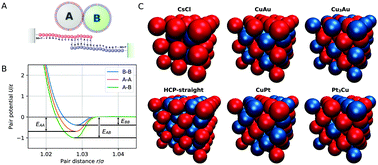当前位置:
X-MOL 学术
›
Soft Matter
›
论文详情
Our official English website, www.x-mol.net, welcomes your feedback! (Note: you will need to create a separate account there.)
Assembly of three-dimensional binary superlattices from multi-flavored particles.
Soft Matter ( IF 3.4 ) Pub Date : 2018-07-10 00:00:00 , DOI: 10.1039/c8sm00989a Evan Pretti 1 , Hasan Zerze , Minseok Song , Yajun Ding , Nathan A Mahynski , Harold W Hatch , Vincent K Shen , Jeetain Mittal
Soft Matter ( IF 3.4 ) Pub Date : 2018-07-10 00:00:00 , DOI: 10.1039/c8sm00989a Evan Pretti 1 , Hasan Zerze , Minseok Song , Yajun Ding , Nathan A Mahynski , Harold W Hatch , Vincent K Shen , Jeetain Mittal
Affiliation

|
Binary superlattices constructed from nano- or micron-sized colloidal particles have a wide variety of applications, including the design of advanced materials. Self-assembly of such crystals from their constituent colloids can be achieved in practice by, among other means, the functionalization of colloid surfaces with single-stranded DNA sequences. However, when driven by DNA, this assembly is traditionally premised on the pairwise interaction between a single DNA sequence and its complement, and often relies on particle size asymmetry to entropically control the crystalline arrangement of its constituents. The recently proposed “multi-flavoring” motif for DNA functionalization, wherein multiple distinct strands of DNA are grafted in different ratios to different colloids, can be used to experimentally realize a binary mixture in which all pairwise interactions are independently controllable. In this work, we use various computational methods, including molecular dynamics and Wang–Landau Monte Carlo simulations, to study a multi-flavored binary system of micron-sized DNA-functionalized particles modeled implicitly by Fermi–Jagla pairwise interactions. We show how self-assembly of such systems can be controlled in a purely enthalpic manner, and by tuning only the interactions between like particles, demonstrate assembly into various morphologies. Although polymorphism is present over a wide range of pairwise interaction strengths, we show that careful selection of interactions can lead to the generation of pure compositionally ordered crystals. Additionally, we show how the crystal composition changes with the like-pair interaction strengths, and how the solution stoichiometry affects the assembled structures.
中文翻译:

由多味粒子组装三维二元超晶格。
由纳米或微米尺寸的胶体颗粒构建的二元超晶格具有广泛的应用,包括先进材料的设计。在实践中,通过用单链 DNA 序列对胶体表面进行功能化等方式,可以从其组成胶体中自组装此类晶体。然而,当由 DNA 驱动时,这种组装传统上以单个 DNA 序列与其互补序列之间的成对相互作用为前提,并且通常依赖于粒径不对称性来熵控制其成分的晶体排列。最近提出的用于 DNA 功能化的“多风味”基序,其中多个不同的 DNA 链以不同的比例移植到不同的胶体上,可用于实验性地实现二元混合物,其中所有成对相互作用都是独立可控的。在这项工作中,我们使用各种计算方法,包括分子动力学和 Wang-Landau 蒙特卡罗模拟,来研究由费米-贾格拉成对相互作用隐式建模的微米级 DNA 功能化粒子的多风味二元系统。我们展示了如何以纯焓方式控制此类系统的自组装,并通过仅调整类似粒子之间的相互作用,展示组装成各种形态。尽管多态性存在于广泛的成对相互作用强度中,但我们表明,仔细选择相互作用可以导致纯组成有序晶体的生成。此外,我们还展示了晶体组成如何随同类相互作用强度的变化,以及溶液化学计量如何影响组装结构。
更新日期:2018-07-10
中文翻译:

由多味粒子组装三维二元超晶格。
由纳米或微米尺寸的胶体颗粒构建的二元超晶格具有广泛的应用,包括先进材料的设计。在实践中,通过用单链 DNA 序列对胶体表面进行功能化等方式,可以从其组成胶体中自组装此类晶体。然而,当由 DNA 驱动时,这种组装传统上以单个 DNA 序列与其互补序列之间的成对相互作用为前提,并且通常依赖于粒径不对称性来熵控制其成分的晶体排列。最近提出的用于 DNA 功能化的“多风味”基序,其中多个不同的 DNA 链以不同的比例移植到不同的胶体上,可用于实验性地实现二元混合物,其中所有成对相互作用都是独立可控的。在这项工作中,我们使用各种计算方法,包括分子动力学和 Wang-Landau 蒙特卡罗模拟,来研究由费米-贾格拉成对相互作用隐式建模的微米级 DNA 功能化粒子的多风味二元系统。我们展示了如何以纯焓方式控制此类系统的自组装,并通过仅调整类似粒子之间的相互作用,展示组装成各种形态。尽管多态性存在于广泛的成对相互作用强度中,但我们表明,仔细选择相互作用可以导致纯组成有序晶体的生成。此外,我们还展示了晶体组成如何随同类相互作用强度的变化,以及溶液化学计量如何影响组装结构。



























 京公网安备 11010802027423号
京公网安备 11010802027423号